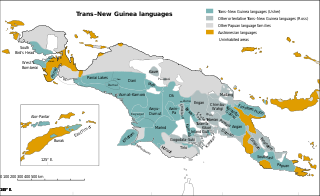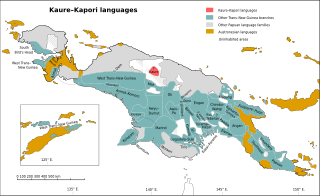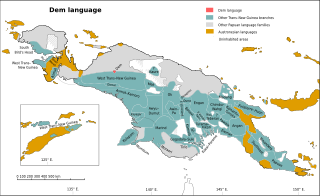Related Research Articles

Trans–New Guinea (TNG) is an extensive family of Papuan languages spoken on the island of New Guinea and neighboring islands, a region corresponding to the country Papua New Guinea as well as parts of Indonesia.
The Sko or Skou languages are a small language family spoken by about 7000 people, mainly along the Vanimo coast of Sandaun Province in Papua New Guinea, with a few being inland from this area and at least one just across the border in the Indonesian province of Papua.

The East Geelvink Bay or East Cenderawasih languages are a language family of a dozen Papuan languages along the eastern coast of Geelvink Bay in Indonesian Papua, which is also known as Sarera Bay or Cenderawasih.
The East Bird's Head–Sentani languages form a family of Papuan languages proposed by Malcolm Ross which combines the East Bird's Head and Sentani families along with the Burmeso language isolate. Sentani had been a branch of Stephen Wurm's proposal for Trans–New Guinea. It has lexical similarities with the Asmat–Kamoro languages, but Ross does not believe these demonstrate a genealogical relationship.

Tause, also known as Doa or Darha, is a poorly-known Papuan language of Indonesia spoken by approximately 500 people, mainly in Derapos village.
Iau or Turu is a Lakes Plain language of West Papua, Indonesia, spoken by about 2,100 people, native speakers of this language are the Turu people (Iau). Most speakers are monolingual, and their number is growing. Other peoples in the western Lakes Plain area speak basic Iau. Iau is heavily tonal, with 11 tones on nouns and 19 simple and compound tones on verbs.

The Kaure–Kosare or Nawa River languages are a small family spoken along the Nawa River in West Papua, near the northern border with Papua New Guinea. The languages are Kaure and Kosare.

The Mek languages are a well established family of Papuan languages spoken by the Mek people and Yali people. They form a branch of the Trans–New Guinea languages (TNG) in the classifications of Stephen Wurm (1975) and of Malcolm Ross (2005).
The Dani or Baliem Valley languages are a family of clearly related Trans–New Guinea languages spoken by the Dani and related peoples in the Baliem Valley in the Highland Papua, Indonesia. Foley (2003) considers their Trans–New Guinea language group status to be established. They may be most closely related to the languages of Paniai Lakes, but this is not yet clear. Capell (1962) posited that their closest relatives were the Kwerba languages, which Ross (2005) rejects.
Momuna (Momina), also known as Somahai, is a Papuan language spoken in Yahukimo Regency, Highland Papua and Asmat Regency, South Papua, Indonesia.

Dem is a divergent Papuan language of West New Guinea. Although Palmer (2018) leaves it unclassified, it was tentatively included in the Trans–New Guinea family in the classification of Malcolm Ross (2005), and Timothy Usher ties it most closely to Amung.
The Orya–Tor languages are a family of just over a dozen Papuan languages spoken in Western New Guinea, Indonesia.
The Sko or Skou languages are a small language family spoken by about 7000 people, mainly along the Vanimo coast of Sandaun Province in Papua New Guinea, with a few being inland from this area and at least one just across the border in the Indonesian province of Papua.
Fayu, also known as Sehudate, is a Lakes Plain language of Papua Province, Indonesia spoken by about 1,400 Fayu people. It is spoken in Foida and other nearby villages.
Sikaritai (Sikwari) is a Lakes Plain language of Papua, Indonesia. It is named after Sikari village in Rafaer District, Mamberamo Raya Regency. Alternate names are Aikwakai, Araikurioko, Ati, Tori, Tori Aikwakai.
Duvle (Sikwari) is a Lakes Plain language of the Papua, Indonesia. It is spoken in Dagai village in Dagai District, Puncak Jaya Regency.
The Abawiri language is a Lakes Plain language of Papua, Indonesia. It is spoken in the village of Fuau, located along the Dijai River, a tributary to the Mamberamo River. Clouse tentatively included Abawiri and neighboring Taburta (Taworta) in an East Lakes Plain subgroup of the Lakes Plain family; due to the minimal data that was available on the languages at that time. With more data, the connection looks more secure.
Awera is a Lakes Plain language of Papua, Indonesia. It is spoken on the east side of Geelvink Bay, in the single village of Awera in Wapoga District, Waropen Regency, Papua. The village has a majority of Ansus (Austronesian) speakers.
Waritai is a Lakes Plain language of Irian Jaya, Indonesia. It is spoken in Taiyeve.
Obokuitai (Obogwitai) is a Lakes Plain language of Papua, Indonesia. It is named after Obogwi village in East Central Mambermano District, Mamberamo Raya Regency.
References
- 1 2 3 4 5 6 Foley, William A. (2018). "The languages of Northwest New Guinea". In Palmer, Bill (ed.). The Languages and Linguistics of the New Guinea Area: A Comprehensive Guide. The World of Linguistics. Vol. 4. Berlin: De Gruyter Mouton. pp. 433–568. ISBN 978-3-11-028642-7.
- ↑ Foley, William A. (2018). "The morphosyntactic typology of Papuan languages". In Palmer, Bill (ed.). The Languages and Linguistics of the New Guinea Area: A Comprehensive Guide. The World of Linguistics. Vol. 4. Berlin: De Gruyter Mouton. pp. 895–938. ISBN 978-3-11-028642-7.
- 1 2 3 4 5 Clouse, Duane A. (1997). "Towards a reconstruction and reclassification of the Lakes Plain languages of Irian Jaya". In Karl Franklin (ed.). Papers in Papuan linguistics no. 2 (PDF). Vol. A-85. Canberra: Pacific Linguistics. pp. 133–236. ISBN 0858834421.
- ↑ New Guinea World - Lakes Plains
- ↑ Yoder, Brendon (2018). "The Abawiri tone system in typological perspective" . Language (Phonological Analysis) . 94 (4): e266–e292. doi:10.1353/lan.2018.0067. S2CID 150242777 – via Project MUSE.
- ↑ Bateman, Janet (1986). "Iau verb morphology". NUSA. 26: 1–76.
- ↑ Yoder, Brendon (2020). A grammar of Abawiri, a Lakes Plain language of Papua, Indonesia (PhD thesis). University of California Santa Barbara.
- Clouse, Duane A. (1997). Karl Franklin (ed.). "Towards a reconstruction and reclassification of the Lakes Plain languages of Irian Jaya". Papers in New Guinea Linguistics. 2: 133–236. ISSN 0078-9135. OCLC 2729642.
- Clouse, Heljä; Duane A. Clouse (1993). "Kirikiri and the western Lakes Plain languages: selected phonological phenomena". Language and Linguistics in Melanesia. 24: 1–18. OCLC 9188672.
- Ross, Malcolm (2005). "Pronouns as a preliminary diagnostic for grouping Papuan languages". In Andrew Pawley; Robert Attenborough; Robin Hide; Jack Golson (eds.). Papuan pasts: cultural, linguistic and biological histories of Papuan-speaking peoples. Canberra: Pacific Linguistics. pp. 15–66. ISBN 0858835622. OCLC 67292782.
- Silzer, Peter; Heljä Heikkinen (1991). Index of Irian Jaya languages (Second ed.). Jayapura: University Cenderawasih and Summer Institute of Linguistics. OCLC 26368341.